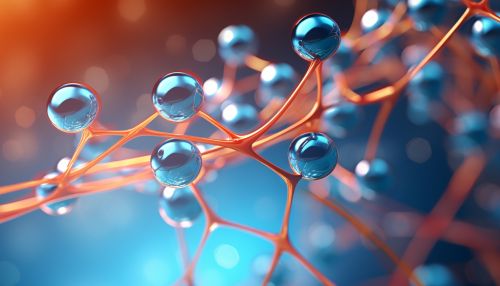Phospholipids
Overview
Phospholipids are a class of lipids that are a major component of all cell membranes. They can form lipid bilayers because of their amphiphilic characteristic. The structure of the phospholipid molecule generally consists of two hydrophobic fatty acid tails and a hydrophilic head consisting of a phosphate group. The two components are joined together by a glycerol molecule.


Structure and Properties
The primary structure of a phospholipid molecule consists of a polar head group, a glycerol backbone, and two nonpolar fatty acid tails. The head group and the glycerol backbone form the hydrophilic "head" of the molecule, while the fatty acid tails form the hydrophobic "tail". This amphiphilic nature of phospholipids allows them to form the basic structure of all biological membranes.
Head Group
The head group of a phospholipid is the polar, hydrophilic part of the molecule. It is composed of a phosphate group attached to a glycerol molecule. The specific nature of the head group can vary between different types of phospholipids, which can include choline, ethanolamine, serine, inositol, and others.
Glycerol Backbone
The glycerol backbone of a phospholipid is a three-carbon molecule that serves as the foundation for the rest of the molecule. The glycerol molecule is attached to the head group at one end and the fatty acid tails at the other.
Fatty Acid Tails
The fatty acid tails of a phospholipid are the nonpolar, hydrophobic part of the molecule. They are composed of long chains of carbon atoms with hydrogen atoms attached. The specific nature of the fatty acid tails can vary between different types of phospholipids, with variations in the length of the chain, the degree of saturation, and the presence of any additional functional groups.
Functions
Phospholipids play a crucial role in many biological processes due to their unique properties. They are the primary building blocks of cell membranes, forming a barrier that separates the inside of the cell from the outside environment. They also play a role in signal transduction, as messengers and as precursors for other signaling molecules.
Cell Membrane Structure
The primary function of phospholipids is to form the lipid bilayer of the cell membrane. The amphiphilic nature of phospholipids allows them to spontaneously form a bilayer in an aqueous environment, with the hydrophilic heads facing the water and the hydrophobic tails facing each other. This structure forms a barrier that separates the inside of the cell from the outside environment, while also allowing for the selective passage of certain substances in and out of the cell.
Signal Transduction
Phospholipids also play a crucial role in signal transduction, the process by which cells respond to external signals. Certain types of phospholipids can be cleaved by specific enzymes to produce secondary messengers, which can then activate other proteins within the cell. This process is a key component of many cellular signaling pathways.
Precursors for Other Molecules
In addition to their role in cell membranes and signal transduction, phospholipids can also serve as precursors for other biologically important molecules. For example, the phospholipid phosphatidylcholine can be metabolized to produce choline, which is a precursor for the neurotransmitter acetylcholine.
Types of Phospholipids
There are several different types of phospholipids, each with their own unique structure and function. These include phosphatidylcholine, phosphatidylethanolamine, phosphatidylserine, phosphatidylinositol, and sphingomyelin.
Phosphatidylcholine
Phosphatidylcholine is the most common type of phospholipid in cell membranes. It has a choline head group, which gives it a net positive charge. This makes it an important component of the outer leaflet of the cell membrane, where it can interact with the aqueous environment.
Phosphatidylethanolamine
Phosphatidylethanolamine has an ethanolamine head group, which gives it a net neutral charge. It is a major component of the inner leaflet of the cell membrane, where it can interact with the cytosol.
Phosphatidylserine
Phosphatidylserine has a serine head group, which gives it a net negative charge. It is primarily found in the inner leaflet of the cell membrane, where it plays a role in cell signaling and apoptosis.
Phosphatidylinositol
Phosphatidylinositol has an inositol head group, which can be phosphorylated to produce various secondary messengers. It is a key component of many cellular signaling pathways.
Sphingomyelin
Sphingomyelin is a type of phospholipid that contains a sphingosine backbone instead of a glycerol backbone. It is a major component of the myelin sheath that surrounds nerve cells, providing insulation and increasing the speed of nerve impulses.
